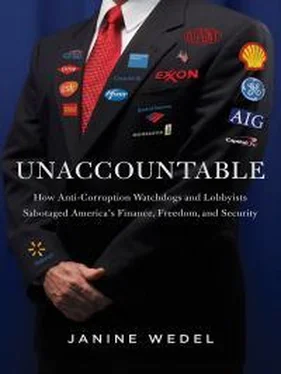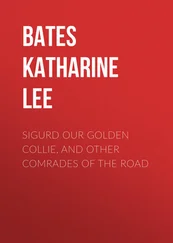[T]he department said that dairy promotion was intended to bolster farmers and rural economies, and that its oversight left Dairy Management’s board with “significant independence” in deciding how best to support those interests.
Dairy Management can also use the government’s imprimatur as a shield when it needs to. When the entity’s billing of dairy foods as a diet aid was challenged as false, writes the Times , “government lawyers defended it, saying the Agriculture Department ‘reviewed, approved and continually oversaw’ the effort.” 103
As we can see, such flex-ability to play different sides lends deniability. Good, perhaps, for government PR, but not so good for accountability to the public.
Far from the world of dairy products is another agency with a conflicted mission: the Minerals Management Service, the U.S. oil-drilling “regulator” that came under scrutiny after BP’s massive oil spill in the Gulf of Mexico, the worst environmental disaster in American history. It took the death of eleven workers and the spilling of nearly five million barrels of oil for the media to take notice.
Was the MMS an arm of the industry, or was it a government regulator? You be the judge of this description, from the Wall Street Journal: 104
It is supposed to be a watchdog that halts drilling when it spots unsafe behavior. But it is also supposed . . . to generate government revenue from drilling on government lands. . . . Of MMS’s fiscal 2010 budget of $342 million, nearly half comes from the oil industry.
No surprise, then, that the MMS had essentially rubber-stamped BP’s plan to explore the Deepwater Horizon well lease. According to its plan, the risk of an oil spill was minimal and “no mitigation measures other than those required by regulation and BP policy will be employed to avoid, diminish or eliminate potential impacts on environmental resources,” according to the Washington Post . 105Should there be a spill, damage to fish, birds, and marine mammals would be minimal, the plan had it. MMS also granted BP’s lease a “categorical exclusion” from environmental-impact analysis by the National Environmental Policy Act—just eleven days prior to the oil-rig explosion. 106
A Wall Street Journal investigation found that the MMS: 107
• doesn’t write or implement most safety regulations, having gradually shifted such responsibilities to the oil industry itself for more than a decade;
• said that offshore drilling is so complicated that only industry can really regulate itself;
• let the industry devise its own solutions to problems;
• let a trade group take over the role of telling companies what training was necessary for workers involved in keeping wells from gushing out of control.
In its defense, the agency “pointed to a 1996 law that encouraged federal agencies to ‘benefit from the expertise of the private sector’ by adopting industry standards.” 108
A few government officials and investigators did try to extract increased oversight of BP long before the massive spill. One EPA official a few years earlier threatened to “debar” BP from government contracts if it didn’t submit to tougher regulation. 109
Such entreaties fell on deaf ears. It is no coincidence, perhaps, that a high-wattage roster of Washington power brokers who had served on government advisory boards and panels was deployed by BP to burnish the company’s image well before the spill. Some were reportedly paid $120,000 a year to . . . “advise.” These include former Democratic Senate majority leader Tom Daschle; two former Republican senators, the late Warren Rudman and Alan Simpson; Bush EPA administrator Christine Todd Whitman; Clinton deputy attorney general Jamie Gorelick; Leon Panetta, before he became President Obama’s CIA director; and former Democratic Senate majority leader George Mitchell (now Penn State’s Athletic Integrity Leader). 110
BP took some of its high-powered advisory board members on a helicopter ride out to the Gulf of Mexico to “demonstrate safeguards.” Whitman told Newsweek: “We got a sense they were really committed to ensuring they got it right.” 111
In 2010, following the disaster, the Obama White House moved to split MMS’s oversight and revenue functions and to increase resources to tip the power back toward the regulators. Thus the “MMS” is no more—in name, that is. It is now two entities: the Bureau of Ocean Energy Management (BOEM) and the Bureau of Safety and Environmental Enforcement (BSEE). 112
But no matter the labels, it’s hard to see how the government can easily reverse what seems to be a virtual takeover by the industry it is supposed to regulate—a meshing of state and private power, with the state getting the short end of the stick.

The rise of the company-state has brought an explosion of unaccountability replete with entities and players who can easily wriggle out of responsibility. Following Edward Snowden’s leaks, security within organizations (including government contractors) has become the new craze. It may be that a big—even the biggest—risk comes from within. But the first place to look is players at the top—and the company-state they power. When they are, by the structure in which they operate, most invested in their own agendas and not that of the public or the nations they supposedly serve, our wallets and possibly our security are compromised.
In the next chapters we’ll see how the same signs of unaccountability we examined with regard to government and the companies and players swirling in and around it—overlapping roles, moving boundaries, and performing for the public, among others—are invading organizations we thought we understood. We’ll see how the way in which enterprises these days are organized—from think tanks, academic expertise, “grassroots” entities, and political endeavors—sows antitransparency and unaccountability. And these enterprises move and shake policies through means of influencing that we may be only dimly aware of, if at all.
CHAPTER 7
Thought Leaders and Think-Tankers
They’ve long been called “universities without students.” Unfortunately, the more accurate name these days for many of the nearly seven thousand think tanks around the world might be “power centers without accountability.” 1
“Power centers”? What happened to the long-term policy studies produced by think tanks for consumption by government, political and policy wonks, or anyone with a shelf? The ongoing work of experts on welfare, or social security, or foreign policy? In the United States, we might think of stodgy establishments like the Brookings Institution, the American Enterprise Institute, the Heritage Foundation, or the Cato Institute—each with its own particular ideological slant and corner office space for out-of-office politicians. In the United Kingdom, we might think of Chatham House.
While these institutions flourished during the Cold War, the number of think tanks worldwide has risen so fast and furiously since the end of the Cold War that we are prompted to ask whether there is really that much more thinking going on. 2By at least one estimate, the United States alone has upwards of 1,900 of these public-policy research organizations today—a figure that’s more than doubled since 1980. 3Considering the large number of organizations that look like think tanks these days, that figure actually may be far higher. 4
It isn’t just the sheer number of think tanks that’s exploded. So have their scope and ambitions. A new species has been born that, while it might still be called a think tank, is a simulacrum of its earlier version.
Читать дальше













